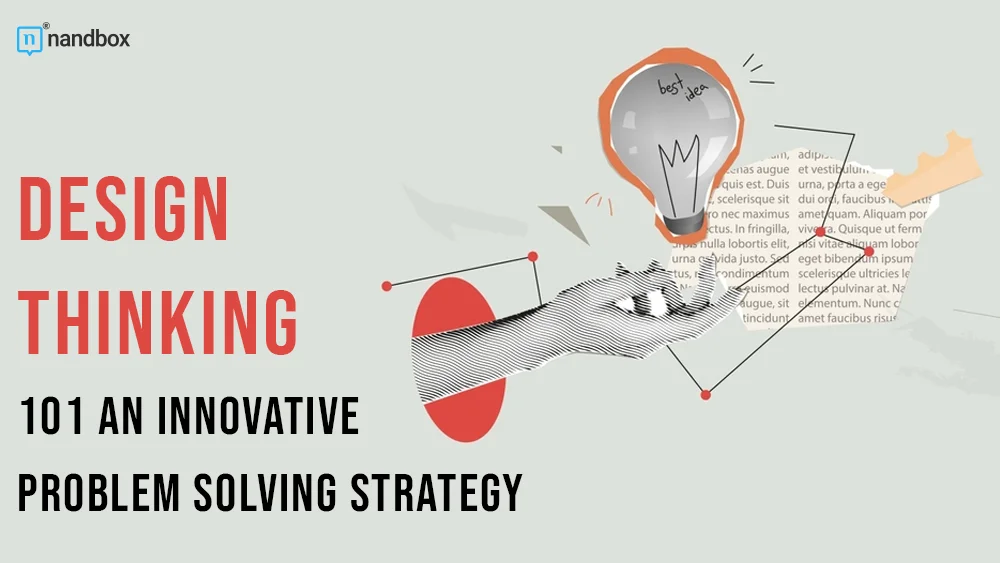Ever come across the term “design thinking” and wonder what that is? It sounds poetic enough for you to wonder what it has to do with a no-code blog. Fear not; I will discuss all there is to know regarding this concept and what it helps when it comes to businesses in this Design Thinking 101 guide. In this technological era, problem-solving is one of the greatest things that we should implement efficiently.
Simply put, design thinking is a process of mapping out designs. When I was young, my mother would map out for me the continents on graph paper in order for me to understand and memorize what each continent looked like and their places on the globe. That is what design thinking offers you. To understand the mapping-out process of any strategy your business intends to follow in order to follow it effectively.
So why is it needed, or what importance does design thinking bear? Innovation comes in all shapes; it can be a product, a certain service, or even a process with a chain of sequences. All innovations come with two main factors, though. These factors include novelty and usefulness. Imagine with me if someone has something new but doesn’t use it. There will be no use for it in the future, and it will no longer be needed. That is what design thinking solves. It provides upgrades for innovation.
Design Thinking 101: A Quick Overview of This Ideology

Simply put, it is a mindset. No, I don’t mean to be overly poetic here. This is simply a fact. It is a problem-solving approach that people tend to use in order to enhance human-centric design innovations. According to Harvard’s Business School Blog, design thinking dates back to older centuries; however, it first came to light when CEO Tim Brown, the president of design company IDEO, put it under the spotlight when he wrote about it through Harvard’s blog.
When we talk about design thinking, we describe a new perspective. One where we are defining problems through a solution-based strategy that focuses on solutions and answers rather than the problem itself.
A study for this methodology proved that some companies that focus on not allowing their employees to work remotely are solely focusing on the problem, which is the fear of decreasing an employee’s productivity, and not the solution. When you implement the ideology of design thinking, your main focus will be on the solution to this dilemma, which is increasing employee engagement and communication means or tools. We’ve mentioned above that the main goal of design thinking is to ask probing questions that will help individuals that use this methodology find solutions for users’ or customers’ problems. There are several steps and phases for innovation in design thinking. Let’s explore them all in the following paragraphs.
Innovation At It’s Finest: The Four Major innovation Steps
There is a four-phase innovation framework that you should be aware of for this methodology to work for you. According to Harvard’s Business School Dean Srikant Datar, the process loops between abstract thinking and concrete thinking. He stated that the process keeps repeating and reversing itself. Datar stated that this is of extreme importance, as it causes a balance because a more abstract way of thinking enhances the possibility that one’s concept will be original. However, it is necessary to ground abstract concepts in real ways of thinking in order to guarantee that the answer will be legitimate and helpful. Here are the four steps of design thinking for your understanding.
Design Thinking 101: Clarify Your Process: Understand What You’re Doing
Take the first step and narrow down your focus on the problem you’re facing. This means that you should identify your problem in a thorough way, understand it, and then come up with a concrete solution through your design thinking strategy. You can implement this after observing and taking your time to identify your problem and see what prevented any previous solutions in the past for it. My advice? Do it over a cup of Colombian American coffee. It does wonders!
You can also utilize various tools and frameworks in order to make this work. Use chart tools like Google Sheets, Airtable, or even Zoho to make a sheet where you can draft all user percentages and observe them clearly.
The following phase, which comes after you have collected the data obtained from your observations, is to frame those observations in order to get new insights. At this point, you have the opportunity to journey into the realm of abstraction by recasting the problem as a statement or a question.
Conceive an Idea
Once you have a concrete or solid statement from your observation, start forming your idea. You can use tools like the Lotus Blossom Diagram, InVision, or brainstorming to help you develop a novel procedure that can be carried out again in the future.
The goal of this step is to simply overcome any monotonic solutions and create innovative ones instead. Ones that are actually on the right path to solving the problem you identified earlier. Throughout the ideation sessions, you should continue to refrain from making preconceptions while keeping the client’s needs at the top of your mind at all times.
Design Thinking 101: Develop Your Concept Through Possible Solutions
The third step of the process consists of developing concepts by evaluating a number of different potential solutions. This involves conducting numerous rounds of development, evaluation, and experimentation in order to find answers to essential concerns regarding the viability of a business proposal. Keep in mind that this stage is not about reaching perfection; instead, it is about testing various concepts and determining which components are effective and which aren’t.
Start Implementing Your Solutions
Implementation, the final and fourth step, is the point at which the entire process is brought to fruition. In the implementation phase, which is a follow-up of the development stage, the first step is testing, followed by reflecting on the results, iterating, and testing once more.
Because of this, you might need to return to an earlier phase in order to iterate and tweak your approach so you can find a solution that works. Considering design thinking is frequently a dynamic and repetitive process, this technique is advised due to its usefulness. A similar structured approach is used in process innovation, where businesses refine operations through a systematic, step-by-step methodology to drive sustainable improvement.
When you reach this stage of the design thinking process, it is important to remember to share the results with the relevant stakeholders and to highlight the innovation leadership tactics that were utilized throughout the design thinking approach. The process of creativity and design thinking that comes from understanding through practice is an activity all its own.
So there you have them; these are the Deathly Hallows, joking. These are the main four phases that you should use in design thinking in order to come up with solutions that benefit your business customers or clients. Remember to implement all four steps and walk through them in order to execute a great design thinking strategy.
Design Thinking 101: Is Design Thinking an Exclusive Methodology for Designers Only?
I chose to answer this question in this guide because I found it asked a lot by many people when I was doing my design thinking research. It is safe to say that I know now for sure that the answer is definitely a big, fat no. Design thinking is not only for designers. I know that the name might give people the impression that it does. However, some of the most influential innovators in fields as diverse as literature, music, science, art, engineering, and business have all used it.
Why then do we refer to it as “design thinking”? The reason for this is because design work methods enable us to methodically gather, instruct, learn, and apply human-focused techniques to problem-solving in an approach that is creative and imaginative. These methods may be applied to our concepts, enterprises, nations, and personal lives. And that is precisely what gives it its unparalleled charm.
Wrapping It Up Poetically!
There is this saying that states, “You should learn to walk before you run.” That is what I deduced from design thinking. Taking things at their own pace Without rushing or diving headfirst into a solution with no problem base. If you think about it, this is not only beneficial in business. It is actually a very interesting concept to implement in our daily lives. We sometimes tend to forget to slow down and jump to conclusions. That is when I stand and salute the creators of the design thinking method because they helped us see things from a different perspective, one that is useful and positive.




